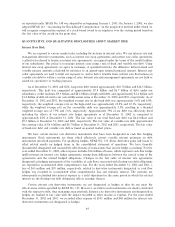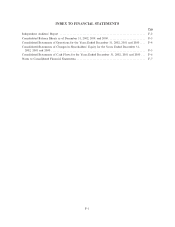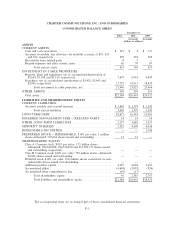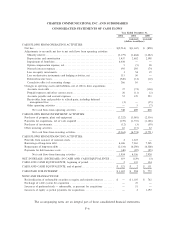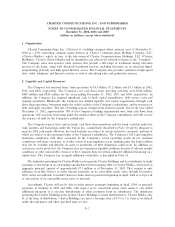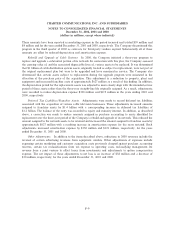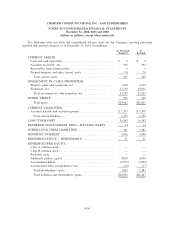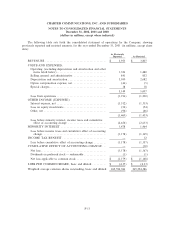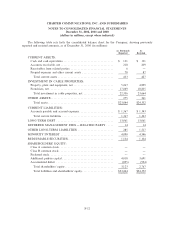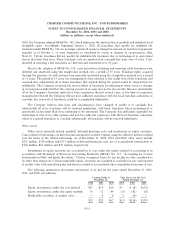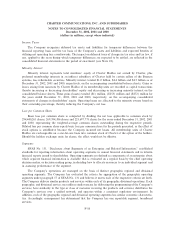Charter 2002 Annual Report Download - page 76
Download and view the complete annual report
Please find page 76 of the 2002 Charter annual report below. You can navigate through the pages in the report by either clicking on the pages listed below, or by using the keyword search tool below to find specific information within the annual report.CHARTER COMMUNICATIONS, INC. AND SUBSIDIARIES
NOTES TO CONSOLIDATED FINANCIAL STATEMENTS
December 31, 2002, 2001 and 2000
(dollars in millions, except where indicated)
The Company's long-term Ñnancing structure as of December 31, 2002 includes $7.8 billion of credit
facility debt, $9.5 billion of high-yield debt and $1.4 billion of convertible subordinated debentures.
Approximately $236 million of this Ñnancing matures during 2003. Note 10 discusses the Company's current
availability and long-term obligations, interest obligations and provides a schedule of maturity.
3. Restatements of Consolidated Financial Results
The Company has identiÑed a series of adjustments that have resulted in the restatement of the
previously issued Ñnancial statements for the years ended December 31, 2001 and 2000. These adjustments
also resulted in the restatements of previously announced quarterly results for the Ñrst three quarters of Ñscal
2002 and each quarter during Ñscal 2001 and 2000, as more fully described in Note 28. In summary, the
adjustments are grouped into the following categories: (i) launch incentives from programmers; (ii) customer
incentives and inducements; (iii) capitalized labor and overhead costs; (iv) customer acquisition costs;
(v) rebuild and upgrade of cable systems; (vi) deferred tax liabilities/franchise assets; and (vii) other
adjustments. These adjustments reduced revenue for the years ended December 31, 2001 and 2000 by
$146 million and $108 million, respectively. The Company's consolidated net loss decreased by $11 million for
the year ended December 31, 2001. Net loss increased by $29 million for the year ended December 31, 2000,
primarily due to adjustments related to the original accounting for acquisitions and for elements of the rebuild
and upgrade activities. In addition, as a result of certain of these adjustments, the Company's statements of
cash Öows have been restated. Cash Öows from operations for the years ended December 31, 2001 and 2000
were reduced by $30 million and $303 million, respectively. The more signiÑcant categories of adjustment
relate to the following as outlined below.
Launch Incentives from Programmers. Amounts previously recognized as advertising revenue in
connection with the launch of new programming channels have been deferred and recorded in other long-term
liabilities in the year such launch support was provided, and amortized as a reduction of programming costs
based upon the relevant contract term. These adjustments decreased revenue by $118 million and $76 million
for the years ended December 31, 2001 and 2000, respectively. Additionally, for the year ended December 31,
2000, the Company increased marketing expense by $24 million for other promotional activities associated
with launching new programming services previously deferred and subsequently amortized. The corresponding
amortization of such deferred amounts reduced programming expenses by $27 million and $5 million for the
years ended December 31, 2001 and 2000, respectively.
Customer Incentives and Inducements. Marketing inducements paid to encourage potential customers
to switch from satellite providers to Charter branded services and enter into multi-period service agreements
were previously deferred and recorded as property, plant and equipment and recognized as depreciation and
amortization expense over the life of customer contracts. These amounts have been restated as a reduction of
revenues in the period such inducements were paid. Revenue declined $19 million and $2 million for the years
ended December 31, 2001 and 2000, respectively. Substantially all of these amounts are oÅset by reduced
depreciation and amortization expense.
Capitalized Labor and Overhead Costs. Certain elements of labor costs and related overhead allocations
previously capitalized as property, plant and equipment as part of the Company's rebuild activities, customer
installations and new service introductions have been expensed in the period incurred. Such adjustments
increased operating expenses by $93 million and $52 million for the years ended December 31, 2001 and 2000,
respectively.
Customer Acquisition Costs. Certain customer acquisition campaigns were conducted through third-
party contractors in 2000, 2001 and portions of 2002. The costs of these campaigns were originally deferred
and recorded as other assets and recognized as amortization expense over the average customer contract life.
F-8


